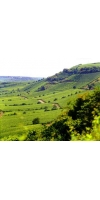Wine from Rheinhessen

Rheinhessen, also known as ‘the land of thousand hills’ is the largest wine region in Germany. It is situated at the southern part of Rheingau, northern part of Pfalz and eastern part of Nahe. Rheinhessen region is characterized by stony soils and warm climate that provide warmth and cultivation to different kinds of grape vines in the region.
Rheinhessen is divided into three regions; Bereich Nierstein, Bereich Bingen and Bereich Wonnegau. Bereich Nierstein is popular for its rich mineral deposits that make it a viable region for grape varietals to grow. Bereich Bingen accounts for majority of red wines produced in Rheinhessen. Bereich Wonnegau is home to Scheurebe grape that makes up about three percent of Rheinhessen’s wine produce.
A Müller-Thurgau grape leads the wine production in Rheinhessen followed by Riesling. Silvaner grape is considered to be the region’s oldest grape varietal but is not commonly produced now as it was before. Dornfelder dominates the red grape production in the region although Pinot Noir from Spätburgunder and Blanc de Noir has grown popular over the years.
No products found
- back
Selected Options
Regions
Categories
Pricing
Countries
Regions
Grape Types
Wineries
Organic/Free Shipping
Peju Winery Legacy Collection Cabernet Sauvignon is made from 88% Cabernet Sauvignon, 6% Petit Verdot, 6% Merlot.
This stunning wine boasts an expressive nose that immediately captivates the senses. On the palate, the wine opens up with complex layers of dried red fruit and hints of cigar box. A subtle hint of wet stone adds a unique touch to the overall experience. The wine's medium to full body creates a beautiful balance between the fruit and tannin structure. The finish is simply divine, with a touch of cocoa dust that lingers on the palate long after the last sip.
Review:
The 2022 Peju Legacy Collection Cabernet Sauvignon is a blend of 88% Cabernet Sauvignon, 6% Petit Verdot, 5% Merlot, and 1% Cabernet Franc, aged for 19 months in 40% new French and American oak, crafted by winemaker Sara Fowler. Fragrant notes of spiced plums, leather, fine cedar, and violets lift from the glass. Full-bodied, it features a framework of elongated, supple tannins, creamy black cherry fruits, dark plum jam, mocha, and a cool wet slate character on the lengthy finish.
-Decanter 94 Points
Napa Cellars Cabernet Sauvignon is made from 100 percent Cabernet Sauvignon.
Napa Cellars Cabernet Sauvignon brims with ripe, concentrated aromas of black currant, loganberry and fig, underscored by threads of warm spice and mocha.
Review:
Aged 21 months in French and Hungarian oak, notes of toasty, spiced cocoa, cassis, and clove are the preamble for the palate’s introduction to this most approachable red. Deep and savory, with black tea, plum, and graphite. Tannins are supple and easy going, and acidity is bright, establishing an energetic finish. - The Tasting Panel, July/August 2025
-Tasting Panel/Somm Journal 92 Points




